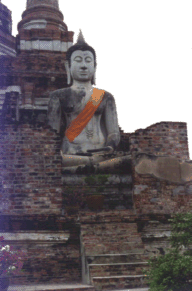
Towards the middle 15th century, the city state of Ayudhaya acceded power from Sukhothai and became the new seat of government for the Thai people for a total of 417 years. The city had been founded on an island at the junction of three rivers. The lowlands surrounding the city flooded annually and was rich in alluvial soil. These natural conditions made Ayudhaya strategically easy to defend. Moreover, being near the Chao Phraya estuary made it accessible by seafaring trading vessels. Thus Ayudhaya became an important trading centre controlling foreign trade with all points northward. It quickly achieved a remarkable state of prosperity. Availability of foreign technology and weaponry also made it immensely powerful among its neighbours.
Ayudhaya rule was based on a concept of kingship different
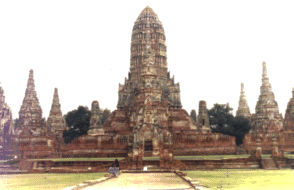 to that of Sukhothai. The king was the incarnation of a deity as derived
from the Khmer concept. The patriarchal system became a feudal
community centre in which all cultural activities and services
took place. The king became the royal patron of the Buddhist faith,
as well as of all the arts.
to that of Sukhothai. The king was the incarnation of a deity as derived
from the Khmer concept. The patriarchal system became a feudal
community centre in which all cultural activities and services
took place. The king became the royal patron of the Buddhist faith,
as well as of all the arts.
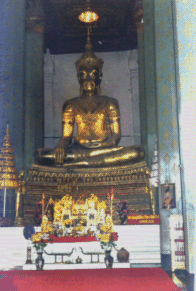 Ayudhaya's income were from its beutiful agricultural products,
and from duties levied against foreign trade. Merchants came from
China, Java, Malaya, India, Sri Lanka, Persia, Japan, Portugal, France,
Holland and England. At its height, Ayudhaya became one of the
most important trading centres in the area. Its prosperity may be
witnessed from its arts, many aspects of which reached perfection
unmatched in Thai history
Sukhothai culture.
Ayudhaya's income were from its beutiful agricultural products,
and from duties levied against foreign trade. Merchants came from
China, Java, Malaya, India, Sri Lanka, Persia, Japan, Portugal, France,
Holland and England. At its height, Ayudhaya became one of the
most important trading centres in the area. Its prosperity may be
witnessed from its arts, many aspects of which reached perfection
unmatched in Thai history
Sukhothai culture.
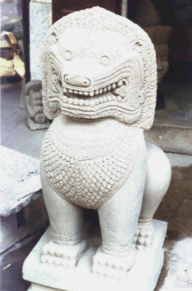 Finally, during the mid 17th century, a new `chedi' form appeared
which was square in plan with multiple redented corners. This Thai
development of an ancient architectural form continued to be built
throughout the rest of the Ayudhaya period and into the Bangkok
period.
Finally, during the mid 17th century, a new `chedi' form appeared
which was square in plan with multiple redented corners. This Thai
development of an ancient architectural form continued to be built
throughout the rest of the Ayudhaya period and into the Bangkok
period.
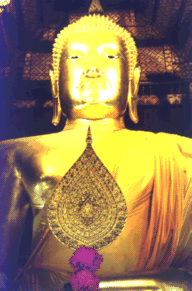
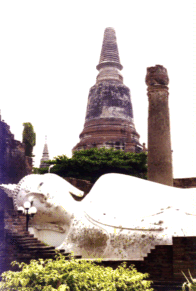 Likewise, Ayudhaya painting developed in three distinct
phases. During the early period, the paintings displayed strong Khmer
origins. Only three colours were known and used : red, black and white.
Remnants of paintings of this early period show juxtaposed rows of
Buddha figures, and ornamental frames presumably backdrops for
Buddha statues. The middle period of Ayudhaya painting exhibits
Sukhothai influence, as may be seen in surviving illustrated manuscripts
`lai rod nam'. This made possible the application of extremely thin
leaves of gold on a lacquer background in free-form designs. It was
used to decorate all things considered valuable from book binders to
whole buildings.
Likewise, Ayudhaya painting developed in three distinct
phases. During the early period, the paintings displayed strong Khmer
origins. Only three colours were known and used : red, black and white.
Remnants of paintings of this early period show juxtaposed rows of
Buddha figures, and ornamental frames presumably backdrops for
Buddha statues. The middle period of Ayudhaya painting exhibits
Sukhothai influence, as may be seen in surviving illustrated manuscripts
`lai rod nam'. This made possible the application of extremely thin
leaves of gold on a lacquer background in free-form designs. It was
used to decorate all things considered valuable from book binders to
whole buildings.
Ayudhaya fell to an invading Burmese army in 1767. This was the culmination of decades of armed conflict between the two countries. The once glorious city was left devastated and without leadership. It was abandoned and quickly went into ruin. The fall of Ayudhaya was so catastrophic that decades after the event, Thais reminisced about "the glorious old city.
 Back to The Thai Heritage Page
Back to The Thai Heritage Page